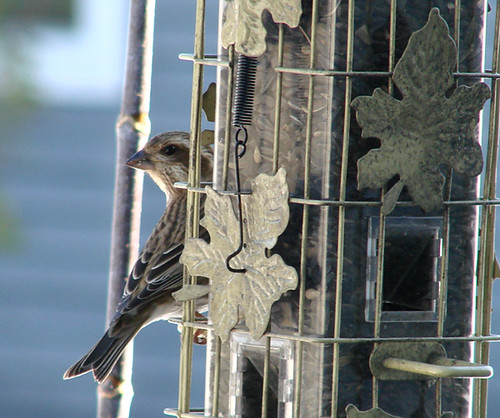tags: Purple Finch, Carpodacus purpureus, birds, mystery bird, bird ID quiz
[Mystery bird] Purple Finch, Carpodacus purpureus -- a hatching-year bird of unknown sex -- photographed in central New York. [I will identify this bird for you tomorrow]
NOTE: Rick says this is a favorite image because it shows the wing formula so well, so in this case, we are going to ask you to age and sex this bird as well as identify it.
Please name at least one field mark that supports your identification.
Rick Wright, Managing Director of WINGS Birding Tours Worldwide, writes:
For many of us, this is an at-a-glance bird: a squat, notch-tailed creature with a pronounced face pattern and a heavy bill. The complex head pattern is startlingly reminiscent of Rose-breasted Grosbeak, but the bird's smaller size (easily measured against the sunflower seeds in the feeder), less triangular bill, and relatively unmarked wing place it firmly among the Carpodacus rosefinches. That genus is widespread and varied in Asia, but North American birders make do with just three breeding species -- Purple, Cassin's, and House Finches -- and a regular vagrant -- Common Rosefinch.
Our mystery photo was taken in central New York, where only one native species occurs; the introduced House Finch, a plain-headed, slender, long-tailed bird, can be eliminated from consideration, leaving us with the correct identification, Purple Finch.
How can we be certain that this is not a wildly wandering Cassin's Finch? I've been puzzled for years that that strongly migratory and mildly invasive species hasn't been recorded east of its normal range; the most extreme records I know of are from the western Great Plains, hardly out of sight of the breeding range. But still, it pays to know how to draw the subtle distinctions between the two, and who knows, some day....
Conveniently, the underparts of our quiz bird are concealed by the feeder at which it was gorging itself, making it impossible to gauge the thickness and density of the streaking or the brightness of the ground color of breast and belly (though that vent is quite a clear white). Instead, we're obliged to focus on the head and, even better, the wing, both of which are sufficient to identify this bird as a Purple Finch of the widespread eastern subspecies.
Let's start with the head. The "cheek" patch is dark, broad, and well set off from the rest of the bright white face. The malar streak is heavy and dark, nearly as strong as the cheek. And the heavy bill shows on close inspection a clear curve to the culmen. On Cassin's Finch, the culmen is straight and the bill often noticeably long and sharp. On that species and on western Purple Finches, the face pattern is more muted, the dark parts paler and the white parts dingier; brown Cassin's Finches usually show a very narrow but distinct whitish eyering, too, clearly lacking on this bird.
A close look at the wing is helpful, too. Though the secondary edgings on this mystery bird are decidedly hoary -- usually considered suggestive of Cassin's Finch -- the wing structure is distinctively that of a Purple. The primary extension (the distance between the tip of the longest tertial and the tip of the longest primary) is only about as long as that tertial; the distance is far greater on Cassin's Finch, making the wingtip look extremely attenuated. The tail of Cassin's Finch is also proportionately shorter, further exaggerating the apparent length of the wingtip. This Purple Finch's wing is "well proportioned."
I believe that the quiz this time asked for not just the species but the age and sex of the bird. There's a bit of a gentle trick here: many species in the genus Carpodacus do not attain adult plumage until after their first complete pre-basic molt, which takes place when they are a year and some months old; thus, both sexes are "female-plumaged" through their first year of life. I've handled hundreds of Purple Finches -- possibly more than any other species -- and always, to my shame, found the brown ones confusing. The shape and condition of the wing coverts don't help us here, as they're invisible; but the shape of the tail feathers might. To my eye, the outer rectrices of this bird are sharply pointed, tapered as is typical of so many young passerines. If that assessment is correct, this is a bird in its first basic plumage, hatched sometime in the six months or so before the October day on which it was photographed, and thus -- because both sexes look like females at that age -- cannot be sexed. In bander's terminology, this is an HY-U Purple Finch: a hatching-year bird of unknown sex. I'd be happy to know if others with more recent and more careful experience of this species in hand has a different opinion.
And finally an aside: when did we stop saying "hatching year" and start saying, barbarously, "hatch year"? Drives me up a wall.
- Log in to post comments


I'm going to say female purple finch, based on the "bold brown and white head pattern" and "long primary projection" (Sibley). I considered female rose-breasted grosbeak, but the head pattern isn't quite right (I'm not seeing the boldly striped crown I'd want to see). Also, this bird's beak is neither pale nor ginormous enough for the rose-breasted grosbeak.
CORRECTION to caption: photographed in central New York.
Totally agree with John, female purple finch. Why? Obvious finch bill, face pattern says Cassin's or purple but bill shape and deeply notched tail says purple to me. Of course, I could be wrong, it happens all the time.
p.s. hi Rick!
Hi back! How are things in Dakota?
FLO - Finch-like object. But some of the wing feathers look almost blue - or is that a reflection?